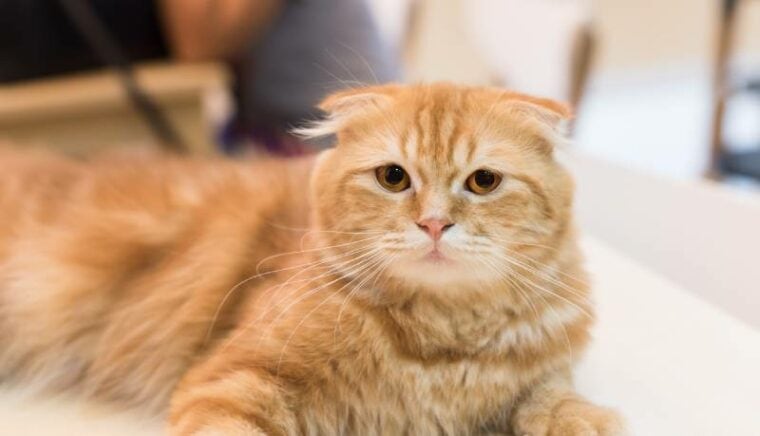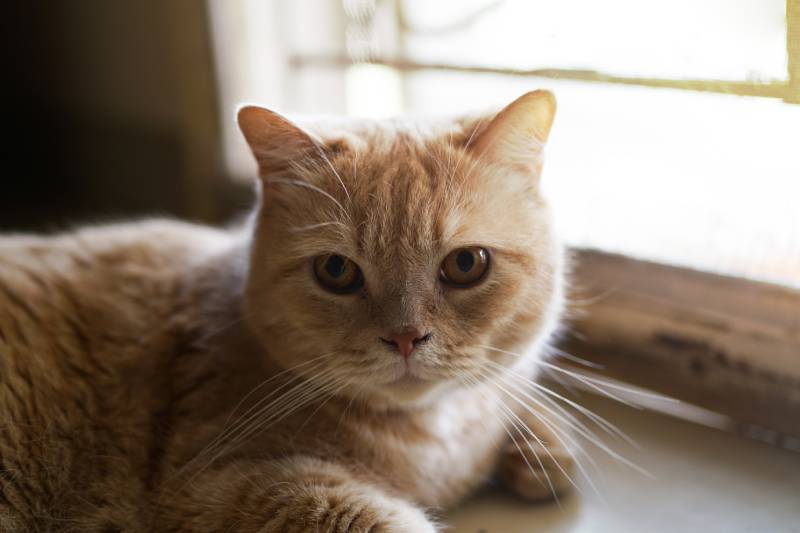
Click to Skip Ahead
Orange Scottish Folds are charming, intelligent, laid-back cats that are well-known for their cute faces and unique ear shape. They’re an excellent addition to the family and get along with everyone. They are prone to some health conditions but can also live a long, healthy life.
Breed Overview
Height:
8–10 inches
Weight:
6–13 pounds
Lifespan:
11–15 years
Colors:
White, black, blue, red, and cream
Suitable for:
Families with children and other pets, single pet owners, people who work from home
Temperament:
Sweet, patient, loving, calm, easy to train, intelligent
They come in many colors and patterns, and their popularity has grown thanks to celebrity owners like Taylor Swift and Ed Sheeran. Some colors are more popular than others, and orange isn’t particularly common.
Orange Scottish Folds are known to be even-tempered, social, affectionate, and laid back. While they are prone to some health problems, they can live long lives—the average lifespan of a healthy cat is 12–14 years, so it’s clear they fall just outside this average.
Orange Scottish Fold Characteristics
The Earliest Records of Orange Scottish Folds in History

Scottish Folds can be traced back to a pregnant Scottish barn cat named Susie. Susie was a regular house cat with an unusual fold in the middle of her ears. She was found by a shepherd named William Ross in 1961, and when she had kittens, he acquired one. All Scottish Folds around today share a common ancestor with Susie.
Scottish Folds are best known for their ears, which are unique and fold forward and down. This fold suggests the cat in question has a gene mutation, but not all cats develop this fold, which makes them unique and rare.
How Orange Scottish Folds Gained Popularity
The demand for these adorable cats is high thanks to their unusual appearance. However, it can be challenging to breed cats with folded ears because the gene mutation responsible for it occurs at random. Of course, this only makes them more popular, alongside their sociable personalities and friendly natures.
There is also the moral question to consider when talking about their popularity: whether it is entirely ethical to deliberately breed a mutation into an animal because humans find it aesthetically pleasing. All colors of Scottish Folds are prone to a disorder called Osteochondrodysplasia, which is linked to the very features they’re so famous for, their folded ears. This disorder is painful and incurable and is characterized by the abnormal development of bone and cartilage. Scottish Folds are also prone to arthritis and obesity.
Formal Recognition of Orange Scottish Folds
It didn’t take long for the Scottish Fold to become popular in the United States. The Cat Fanciers’ Association (CFA) recognized the Scottish Fold in 1973. It was only five years before it was given champion status in 1978.
In the mid-1980s, the CFA recognized the long-haired version, and some associations have also called them by other names, such as the Highland Fold. Scottish Folds might have been discovered in Scotland, but they aren’t recognized as a breed there because of the concern about the health risks associated with their mutation, like the risk of ear infections and deafness.
Top 5 Unique Facts About Orange Scottish Folds
1. They Have Delicate Tails
You must carefully handle your orange Scottish Fold’s tail as they are very delicate and prone to arthritis. While the cats are well-behaved around children, you must teach your kids not to pull at their tails since it can cause them intense pain.
2. They Are Born With Straight Ears
All kittens have straight ears when they’re born, but if they have the mutation, their ears will fold when they’re around 3 to 4 weeks old.

3. They Like to Stand on Their Back Legs
It’s not unusual to find your Scottish Fold standing on its back legs, and it can look a little like a meerkat checking out its surroundings!
4. They Are Very Clever
We all think our pets are smart, but it’s believed that Scottish Folds are one of the most intelligent breeds. This makes them very easy to train.

5. Scottish Folds Aren’t Bred Together
Scottish Folds will usually be bred with British Shorthairs or American Shorthairs because their offspring could be prone to degenerative issues. Their kittens aren’t always born with folded ears, which makes the genetic mutation rare.
Do Orange Scottish Folds Make a Good Pet?
The orange Scottish Folds are wonderful family pets. They’re suitable for families with children and other pets or in households where they are the only pet. They are a good choice for first-time cat owners, and if you choose a reputable breeder, they can live long, healthy lives.
They prefer living in a home where at least one family member works from home, as they don’t like being left alone. They can become destructive if they feel left out or ignored.
This breed is relatively low maintenance when it comes to caring for them. Their short fur only needs to be brushed once every 2 weeks. However, it is recommended that you check their ears often if they have folded ears, as they can become infected if you don’t clean them regularly.
Conclusion
Orange Scottish Folds can be challenging to breed, which only makes them more popular. But it isn’t just their rarity that makes them so popular; they are affectionate, intelligent, calm kitties that are an excellent addition to any family. If you have an orange Scottish Fold in your life or one of the other beautiful colors they come in, we don’t need to tell you how lucky you are!
Featured Image Credit: iChzigo, Shutterstock







